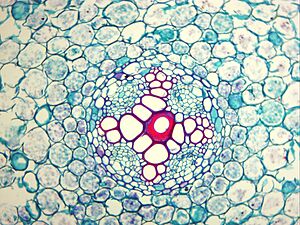Vessel element facts for kids

A vessel element is a special type of cell found in plants. It's part of the xylem, which is like the plant's water pipe system. Xylem helps move water and nutrients from the roots up to the leaves.
You'll find vessel elements in most flowering plants, also known as angiosperms. But they are usually missing from gymnosperms, like conifer trees. These vessel elements are a key difference between the "hardwood" of flowering plants and the "softwood" of conifers.
How Plants Use Vessels
Xylem is the tissue inside vascular plants that carries water. It moves water and dissolved minerals from the roots all the way up to the leaves. Two main types of cells help with this job: tracheids and vessel elements.
Vessel elements are the building blocks of "vessels." These vessels are the main pathways for water transport in flowering plants. They create a very good system for moving water and important minerals. This system goes from the roots to the leaves and other parts of the plant.
When a plant stem gets thicker, new xylem is made. This is called "secondary xylem." A vessel element starts from a long cell called a "fusiform initial." This cell divides to form new vessel elements. The walls of a vessel element become very strong. They get reinforced with a material called lignin.
The side walls of a vessel element have small openings called "pits." These pits allow contact with nearby cells. Tracheids also have pits. But only vessel elements have openings at both ends. These openings connect individual vessel elements. This forms a continuous tube, like a long straw. These end openings are called "perforations." They come in different shapes. The most common are a simple opening or a ladder-like design.
When a vessel element is fully grown, the living part of the cell dies. But its strong, reinforced walls remain. So, a vessel element is a dead cell. However, it still has a very important job. It helps transport water, and living cells around it protect it.
Why Vessels Are Important for Plants
Having vessels in xylem is a big reason why flowering plants are so successful. Scientists once thought that vessel elements only appeared in flowering plants. But now we know that some early flowering plants don't have them. Also, some plants called Gnetales do have them. This means we need to look at this idea again.
It's possible that vessel elements in Gnetales are not the same as those in flowering plants. Or, maybe vessel elements appeared early on. Then some plant groups lost them later.
Similar vessel-like cells have also been found in other plants. These include horsetails, spike-mosses, and some ferns. In these cases, scientists agree that the vessels developed separately. It's even possible that vessels appeared more than once among flowering plants themselves.
See also
 In Spanish: Vaso (botánica) para niños
In Spanish: Vaso (botánica) para niños
- Tracheid


